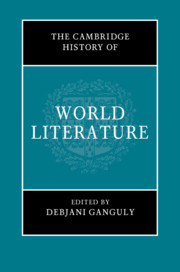Book contents
- The Cambridge History of World Literature
- The Cambridge History of World Literature
- Copyright page
- Contents
- Figures
- Contributors
- Acknowledgements
- Introduction
- Part I Genealogies
- Part II Thinking the World
- Part III Transregional Worlding
- 14 East Asia as Comparative Paradigm
- 15 Latin American Baroque: Or Error by Design
- 16 Comparative World Literature and Worlds in Portuguese
- 17 Africa and World Literature
- 18 Literary Revolution: Ireland and the World
- 19 Korean Worlds and Echoes from the Cold War
- 20 French Colonial Literature in Indochina: Colonial Adventure and Continental Drift
- 21 From Diasporic Tamil Literature to Global Tamil Literature
- Part IV Cartographic Shifts
- Part V World Literature and Translation
- Part VI Poetics, Genre, Intermediality
- Part VII Scales, Polysystems, Canons
- Part VIII Modes of Reading and Circulation
- Part IX The Worldly and the Planetary
- Index
- References
15 - Latin American Baroque: Or Error by Design
from Part III - Transregional Worlding
Published online by Cambridge University Press: 17 August 2021
- The Cambridge History of World Literature
- The Cambridge History of World Literature
- Copyright page
- Contents
- Figures
- Contributors
- Acknowledgements
- Introduction
- Part I Genealogies
- Part II Thinking the World
- Part III Transregional Worlding
- 14 East Asia as Comparative Paradigm
- 15 Latin American Baroque: Or Error by Design
- 16 Comparative World Literature and Worlds in Portuguese
- 17 Africa and World Literature
- 18 Literary Revolution: Ireland and the World
- 19 Korean Worlds and Echoes from the Cold War
- 20 French Colonial Literature in Indochina: Colonial Adventure and Continental Drift
- 21 From Diasporic Tamil Literature to Global Tamil Literature
- Part IV Cartographic Shifts
- Part V World Literature and Translation
- Part VI Poetics, Genre, Intermediality
- Part VII Scales, Polysystems, Canons
- Part VIII Modes of Reading and Circulation
- Part IX The Worldly and the Planetary
- Index
- References
Summary
The hybrid name for Latin America is a clue to its double consciousness and, as a corollary, to its talent for exploring complexity. A push and pull between competing classical and local lineages among displaced and replaced peoples has brought curses on Latin America, but also the blessings of an unbidden freedom to invent new patterns. If bitterness haunts the deracination on a continental scale, irreverence lightens the burden. From colonial times through the current post-Boom period, Latin American literature has been a vehicle for cagey revenge against metropolitan conventions, and for re-membering aboriginal cultures. The legend of Inkari, for example, literally foretells how the body of the Inca emperor, dismembered by Spanish conquerors, will reassemble underground and emerge triumphant. Double consciousness in Latin America describes a culture of baroque anxiety and compensation for doubt about one’s place in the world. With Afro-Latin American literature, the ironies multiply exponentially. Architectural monuments to excess -- meant to overwhelm worries that followed from the discovery of sophisticated cultures that had no debts Europe – worries about the nature of God, the center of culture, one’s own identity -- are visible throughout the continent’s landscape. Local gods and African orishas adorn Catholic temples. Excess is audible too, in the complex strategies for addressing readers, starting from colonial times and reviving after interruptions of purposeful coherence and optimism. The great first masters of Latin American literature were baroque, practically by default as they navigated conflicting codes and overwhelmed the fault lines with clever structures. As pioneers of local style, they set the tone for future movements, through the taste for complexity waffled when political ambitions for independence or national consolidation triumphed through foundational fictions written by political leaders in order to win the hearts of newly minted citizens. Compared to the skillful jousts with European conventions by baroque masters, nation builders and populists would seem naïve to the ironic novelists who ignited a Boom in Latin American literature and who brought European readers face to face with the structural contradictions of modern cultures.
- Type
- Chapter
- Information
- The Cambridge History of World Literature , pp. 295 - 309Publisher: Cambridge University PressPrint publication year: 2021

